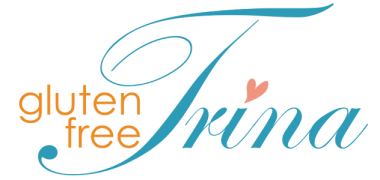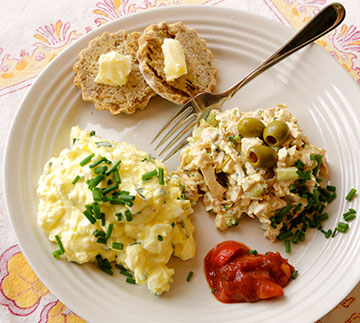How do you safely eat out on a gluten-free diet and ensure any other dietary issues are taken care of? This article provides information for restaurants and can help you with your gluten-free food preparations. It also offers advice if you are new to this diet or entertaining gluten-sensitive and celiac friends.
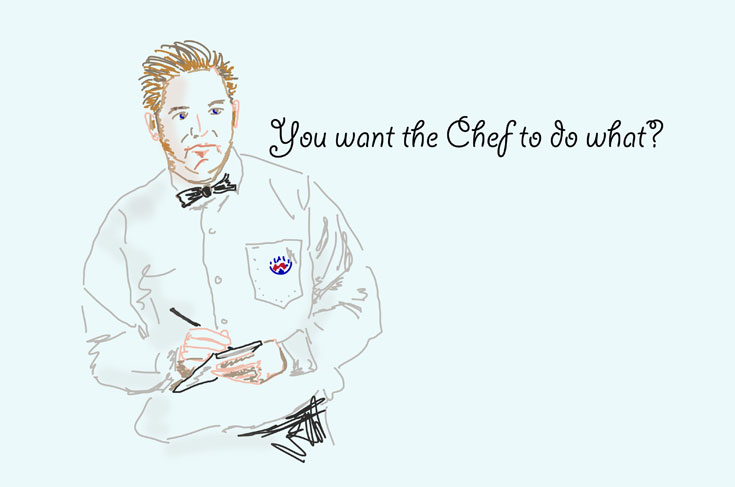
gluten-free, lactose-free, nut-free, and?
This is one of the issues gluten intolerant and Celiac people such as me face every time we eat out. How do we avoid unintentionally eating something that is not gluten-free and avoiding a dreaded reaction? This is a concern many of us face every time we decide to deviate from our usually safe methods of controlling our food intake. I hope you will find this lighthearted advice informative and helpful and make dining out a little easier for you.
Also included at the bottom of this post.
gluten-free customers are the most grateful
1. A Printable Sheet of Questions to ask at a restaurant.
2. Guide for Restaurant Best Practices for Safe Gluten-Free Food handling.
Here is a list of steps you can take when deciding to eat out.
- First, you research the place you intend to eat at. If you are going out with family or friends, you want to pick a place that will be enjoyable for them and yet have some safe options for you. It is no fun being totally centered out, so try and arrange things ahead of time. You can even notify the restaurant ahead of time when you make the reservation. Of course, fast food restaurants are not in that category.
- Once you are ready to place your order, check with the server. They will double-check with the Chef that what you are ordering will be OK according to your dietary needs.
- Ask if they are aware of cross-contamination issues and take the necessary precautions.
- Let the server know if you are gluten intolerant or Celiac and that you are ordering gluten-free as it is not a choice but a necessity for you. This makes a point, and many times, it will be taken very seriously. The reason this is necessary is that —on the one hand, gluten-free has become popular and is offered more than in years gone by. On the other hand, many people sometimes adopt a gluten-free diet only as a preference and do not require the same degree of caution.
- “Gluten-Free” vs. “Gluten-Friendly”: ‘Gluten-Friendly’ means the restaurant offers gluten-free food choices or will alter menu items to be gluten-free. Unfortunately, the restaurant does not guarantee that the food has not come into contact with gluten. This is mostly a legal issue, so if the patron has a reaction, they have not guaranteed the food will be gluten-free. You must make your own choices in this regard.
Although I am very sensitive, after having asked the right questions and being reassured by the answers, I was able to place my order and enjoy the food without incident. When you specify that you are on a gluten-free diet for health reasons, most chefs and servers are very accommodating and recommend the safest entrees. - Many restaurants featuring international cuisine have some ‘naturally gluten-free’ items on the menu. Various cultures sometimes use almost no wheat flour. You still need to be careful and ask, though. For instance, I love those little Sesame Rice Balls that are available in some Chinese restaurants. They are made entirely from gluten-free ingredients, sweet rice flour, and sesame seeds. Sometimes, deep-fried foods prepared at a Chinese restaurant are prepared in a ‘small batch’ wok fryer. This means that a particular type of dish is prepared only in that Wok. However, one time, I had a problem after eating some of these, and later discovered they were prepared in a large traditional vat-style deep fryer that was also used to deep fry wheat dough bread. Now I only enjoy these sesame balls when I make them at home.
- If you are new to this diet, be patient with yourself. We have all been there and have learned along the way.
- Please see below for a Printable Explanation to help you when necessary in explaining your situation at a restaurant.
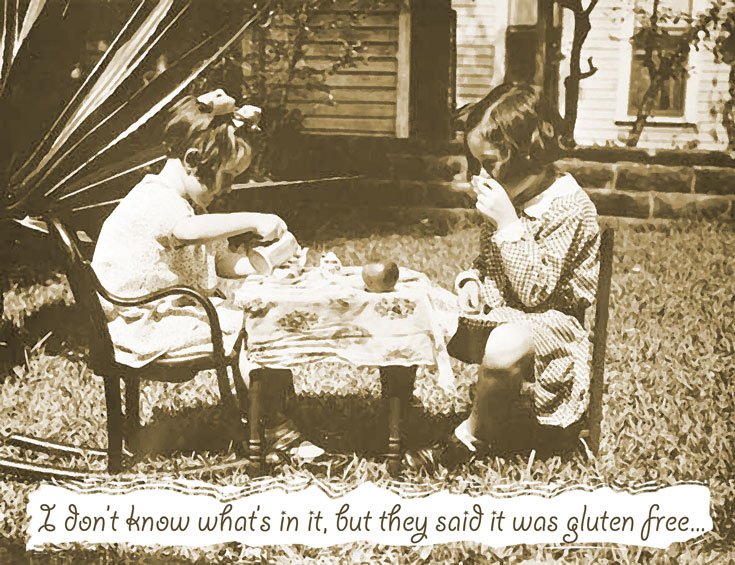
Heritage Image Collection
Eating out with food sensitivities or allergies can be a challenge
Eating out is often both a necessity and a welcome social experience. Never eating out would mean we deny ourselves a lot of great times with family, friends, and business associates, as well as convenience. Fortunately, there are many more gluten-free choices than ever… but we still must be careful.
Many of the larger chains are now recognizing the need for clarity and include symbols on the menu (or have a separate list that you can ask to see) that share food intolerance information alongside their menu items. It is easier to eat out gluten-free than it used to be as establishments understand more about our diet and aim to offer more gluten-free items. Still, you need to take a few precautions to ensure that you are taking steps to ensure your order is safe for you.
You try not to be “centered out,” but it is best to ask the waiter or waitress to point out what the best things are for you on the menu. Most people are very considerate and will double-check for you. This also gives them a chance to alert the chef so that special food handling can be implemented. A few questions will also help you to decide how knowledgeable and accommodating the establishment is. Most places now understand that for many of us, a gluten-free or other dietary restriction is not a choice but a necessity. However, it is still important to state this since the gluten-free diet has become popular. Sometimes, if the diner does not state the necessity, it can be assumed that the gluten-free request might only be a preference, in which case the food handling might not be as strict.
Know what items on a menu could be suspect…
- Anything deep-fried. Ask if the fryer is dedicated to gluten-free. If not, you could risk cross-contamination.
- Grilled foods can be safe as long as the grill is not used for other foods containing flour. If so, the grill needs to be cleaned between uses, and this is not often possible in a busy restaurant kitchen.
- Toast made with Gluten-Free Bread; ask if it is toasted in a dedicated toaster. -Most restaurants offering gluten-free bread have a supply in the freezer in order to keep it from getting stale. In order to be served, it needs to be heated or toasted. Sometimes they have a dedicated toaster, which takes up minimal space, but sometimes they don’t.
- Salad dressings can have hidden gluten-containing ingredients.
- For pasta dishes, make sure the pasta is gluten-free.
- Vegetarian Dishes: Sometimes, especially at a banquet, vegetarian options are offered. This often is heavy on the pasta, and to avoid having to prepare too many separate dishes for a large group, gluten-free dieters will be offered the vegetarian option. If this is so, you must make sure they understand gluten is anything with wheat or flour in it in general. Sometimes, the vegetarian pasta served is gluten-free, and sometimes it is not.
- Desserts are usually not gluten-free unless specifically made gluten-free. Ice cream and fruit are usually safe options. You still need to inquire as, for instance, Cookie Dough Ice Cream is definitely not normally gluten-free.
- A good tip is to understand what ingredients are often normally used in cooking and baking. For instance, lemon pie filling can be made with wheat flour or cornstarch. Pumpkin pie filling does not normally include wheat flour. Although you may decide only to eat the filling, this is not really safe as some of a wheat pie crust could sneak into the filling during baking. Potatoes, mashed or as a salad, normally do not have any wheat flour added as a general rule. Always ask… when eating out; I have been surprised a few times by something that is normally gluten-free being prepared with a gluten-full ingredient.
- Rice is naturally gluten-free, but I learned the hard way that some chefs like to add a little wheat flour to make the rice dish creamier.
Here are a few very basic Gluten-Free Tips and Choices when you are eating out.
- Plain baked potato (with butter or sour cream)
- Steak cooked on a grill
- Beware of French Fried Potatoes or anything deep-fried: You need to check to see that a dedicated gluten-free fryer and oils are used in the preparation. Foods battered with wheat leave traces of gluten in the frying oils and can cause unintentional gluten exposure.
- Some French Fry Trucks and ‘New York Fries’ outlets offer dedicated fryers.
Also, note that Malt Vinegar has gluten in it. - Be careful of any sauces; they are usually thickened with wheat flour.
- BBQ Chicken (plain, no seasoning). Some seasonings are gluten-free. Ask to be sure.
- Steamed or grilled fish & vegetables
- Fresh Fruit
- Salads: Ask about the dressings; some contain gluten ingredients. A good, freshly made salad should be gluten-free. However, say, no croutons (unless they are made from gluten-free bread). Politely ask, “Please have the chef make my salad fresh.” Ask whether the dressing is gluten-free. Oil and vinegar dressings should be ok as long as they don’t use malt vinegar. However, many of the commercially made vinaigrette dressings can contain some gluten-full ingredients. Plain lemon juice and olive oil dressings are safe.
- Spices: Fortunately, spices on their own are mostly gluten-free. However, processing can make a difference. I’ve noticed that on some labels, the wording (spices) is used, but not which ones. This is often because spice blends are a proprietary ingredient and don’t have to be listed. In this case, there must be a Gluten-Free label if it is advertised as such. A few years ago, I worked with a company that packaged gluten-free spices. I was asked to take some home and try them. Unfortunately, I had a severe reaction and could not understand why. On the label, everything that was listed was a naturally gluten-free spice. However, there was a segment listed in parentheses of several ingredients, which also looked gluten-free. When an investigation was conducted into the supplier of that spice mixture, it was found that they blended their spice mixture in equipment also used to process wheat gravy mixes.
- Rice: Though rice is naturally gluten-free, don’t assume a rice dish is. Sometimes they add wheat flour as a thickener in a sauce.
- Knowing what is in common recipes for traditional foods helps you understand if something might be safe to eat. For instance, Lemon pie filling is often made using cornstarch as a thickener, but it can also be made using wheat flour, making it unsafe.
More restaurants cater to a gluten-free diet now; this is awesome! Still, we have to assume responsibility for ourselves and ask the right questions.
Be kind, Be reasonable, and Be appreciative!
I would like to add, at this point, that you be a considerate gluten-free customer. Being angry or upset only makes it hard for the next person who is trying to get information. We don’t want to be known as ‘those picky gluten-free eaters’… We don’t want them to give up and cease to offer anything gluten-free. Just as we expect and hope that the establishment’s personnel will be kind and go out of their way to help us eat safely, we want to show them we appreciate their help. Always say, ‘Thank You for your help!”
We all have stories to tell about that unfortunate experience. I share only to save you, I hope. I can only rave when things go right. But ranting is OK, too, sometimes, and perhaps someone will see this, understand us better and make things a little easier for Celiac customers.
A polite suggestion for Restaurateurs. Often I am traveling and need to eat breakfast at a restaurant. Quite often now, I’m offered gluten-free toast… The thought of a nice piece of toast, even though I make my own gluten-free bread and toast at home, I think would be very nice. I start picturing a lovely breakfast of eggs and bacon with a side of toast… Then as a second thought, I ask, “Is the toaster dedicated gluten-free?” To which the waitress in almost every restaurant has replied NO. So, no toast for me! Now I ask you, how expensive would one little dedicated toaster be that you can’t offer that?
This brings up another unintentional ‘glutening’ experience.
My husband and I were out for a walk; we loved to walk down a quaint street in a small town and browse through the shops. Sometimes there is a street fair going on, and this is a lot of fun. There is a coffee shop, and since coffee and tea are gluten-free, it is a treat to go in and sip on a cuppa. Usually, we can only look wistfully at the baked goods or other offerings. Though if they serve ice cream, well, in a cup without the cone, we can have most of those; still, we must look at the chart to be sure it is gluten-free ice cream.
You get used to living a gluten-free lifestyle, but once in a while, you look longingly at the delicious foods in front of you to see if there is anything you can have.
On one such occasion, we read a sign in a coffee shop and bakery, “TRY OUR NEW GLUTEN-FREE COOKIES.” Yes, sure enough, a nice little selection of delicious-looking tiny little cookies looked right up at us and dared us to try them.
I asked the usual questions.
- What ingredients are in the cookies? Are they sourced gluten-free?
- Are they made here?
- If so, are there precautions taken to avoid cross-contamination?
We decided to take a chance after being assured that the ingredients were sourced from a dedicated gluten-free facility. They were made in the coffee shop bakery, and precautions were always taken to avoid cross-contamination, I was told. We ordered an assortment of cookies to share since we both must eat gluten-free, and proceeded to enjoy them with our coffee. Unfortunately, I either did not get enough information, or the server did not have the right information… as we both had very adverse reactions to the cookies. It took almost a month to feel like ourselves again.
So why do we need to make so sure? Because of bitter experience…
How can an eatery or coffee shop understand why we are asking? Why do we need to be sure… What could make the customer’s experience better?
- Please take people who say they need gluten-free foods seriously!
- Taking steps to provide ready information can save your establishment money. If getting the right answers takes too much time away from the server, it costs you more money. Plus, it keeps customers waiting and lessens the chance of good customer service experiences. Believe me, having a positive experience means repeat visits and gluten-free people don’t always dine alone. In fact, one of the main reasons for going out to eat is to be with family or friends.
- Have a list of ingredients that are easily referred to by staff. Or even better, provide or display a list to show the customer.
- Train your staff in the proper handling of foods to avoid cross-contamination.
- When purchasing foods and ingredients that go into your creations, why not get items that are safe at the outset? Too many naturally gluten-free foods are made unsafe for us only due to the addition of one gluten-containing offender or because your food supplier does not use adequate cross-contamination safety methods.
- Why should you care? Because statistically, those needing a gluten-free diet usually do not dine alone. The group chooses the restaurant so that there will be a gluten-safe option for the one or two people who need it in the group. Did you know that only 3% of the population is Celiac? Yes, but new data confirms that up to 50% of people can be “gluten-sensitive.” Though not as serious an issue, the symptoms can often be the same.
Try and keep a sense of humor!
It is no joke. Someone with a peanut allergy who eats something with peanuts can cause immediate concern and danger. It can kill a person that is allergic right away! This is why they usually always carry an EpiPen. Eating gluten when you are Celiac or Gluten-Sensitive is just as bad… it will just take much longer to kill you!
Why is an Ingredients List Important?
Question: Some might say… “Well, if it says gluten-free… why do you need to know the ingredients list?”
Answer: Unfortunately, many of us on a gluten-free diet, not by choice, have other food intolerances and need to know if the other ingredients are safe for us.
Other Common Allergies or Food Sensitivities
Believe it or not, some Gluten-Sensitives and Celiac must also avoid Corn, which is gluten-free and tolerated by many of us. Tapioca is a good substitute, but then there are those people who are also tapioca intolerant…
Dairy is also sometimes an allergen. Some people who are allergic to dairy cannot tolerate milk but can have butter and 35% cream. An individual who has an allergy will know what is best for them.
Eggs are an Allergen for some. I know a woman who is egg intolerant, and although she is not gluten intolerant, the food choices can be very limiting. Some are allergic to legumes and Soy. Oats are one of the safe grains for Celiacs if processed correctly, yet some who are gluten-sensitive cannot tolerate even safely processed Oats. This can cause concern when a baked good at a fair, for instance, is claimed to be gluten-free. Without an ingredients list how will the customer know?
As mentioned, Tree Nuts and Peanuts can be dangerous for those who are allergic to them. This includes coconut for some.
- Also, Seeds -like Sesame sometimes cause allergic reactions.
- Beans, in particular, Soybeans.
- Oatmeal is only safe if processed in a gluten-free facility. Some people, however, cannot eat oats, regardless.
- Tomatoes, Potatoes, or all Nightshade Plants can cause some people.
- Strawberries, Apples… even Rice and Tapioca… well, you get it, the list of allergens is almost endless.
- For this reason, I included Nightshade Free ingredients as well as Rice and Tapioca Free Gluten-Free flour blend recipes in my cookbook. All are peanut and tree-nut free.
Top Foods causing allergic or intolerance reactions.
- Wheat
- Gluten (a protein contained in wheat, barley, and rye. Is not an allergen but causes reactions for some people who have an autoimmune disorder)
- Peanuts
- Tree nuts – including Coconut
- Eggs
- Milk
- Fish
- Shellfish
- Soybeans
Less Common Foods causing allergic or intolerance reactions.
- Sesame Seeds and Sesame Oil
- Avocados
- Corn
- Mango
- Sulfites – also referred to on labels as Sulfur dioxide. Potassium bisulfite or potassium metabisulfite.
- Nitrate Additives
- Strawberries
- Apples
- Some beans or pea proteins
- Tapioca
- Potato
- Beans and Peas
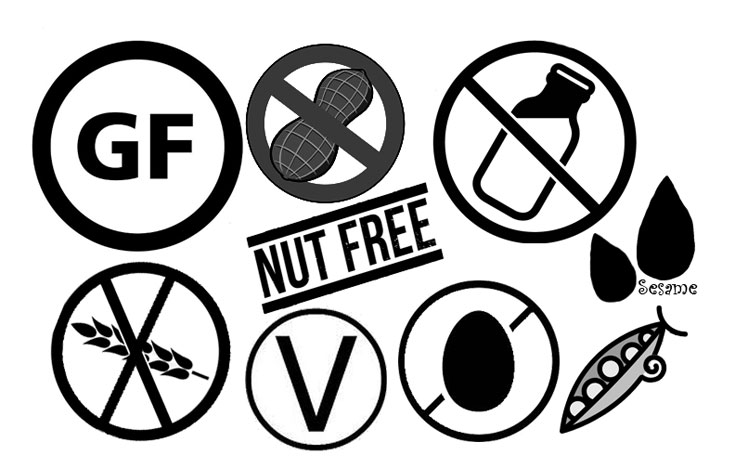
A Request for Gluten-Free Service Please
- Dear Chef, Restaurant Manager or Food Services Professional,
- Before I place my order. Please let me know what items on your menu are or can be freshly prepared in a gluten-free manner.
- Please be aware that I cannot eat any gluten-containing foods made with wheat, rye, barley, or (oatmeal unless processed in a gluten-free facility) and/or their grains or extracts. Gluten in any form is not safe for me to consume.
- This is due to a diagnosis of Celiac Disease or Gluten Sensitivity, and I must abide by a strict gluten-free diet.
- Please let me know if you are aware of the best practices for preparing gluten-free foods to avoid cross-contamination.
- If you are unsure about any food item, I prefer to substitute something else. I can eat a great many foods as long as they are not prepared using foods containing gluten.
- Other food allergies/intolerances that I have are noted below:
______________________________________________________________________ - I understand that the law does not require a restaurant, cafe, or food cart to give ingredient lists or allergy warnings. I understand that the foods I eat are my responsibility. I am, however, most appreciative of any help in this regard that you offer and only seek a mutually beneficial experience.
Thank you for your kind consideration. I appreciate your help in this matter very much.
Best Practices for Gluten-Free Food Preparation
- Use a freshly cleaned prep area (and/or specifically dedicated prep area) to prepare Gluten-free foods and avoid cross-contamination.
- Use fresh gloves when handling gluten-free foods.
Wash hands frequently. - Use clean bowls and utensils to prepare food. i.e., salads, etc. Do not reuse a salad bowl that has been used to prepare a different salad.
- If possible, use dedicated pots, pans, and utensils in preparing gluten-free foods. Otherwise, make sure they have been cleaned extremely well. See the next step.
- Kitchen Equipment For Gluten-Free Cooking and Baking
Gluten can stick to cooking and baking pans, dishes, and utensils. You can run them through a dishwasher to clean them after using them for wheat cooking. They must be rinsed before going in the dishwasher, and to be sure, run them through twice. You can also wash by hand using hot soapy water and a clean scrubbing pad with mildly abrasive characteristics to remove any stuck on gluten-particles.
Some cooking utensils that can’t be easily cleaned and should be dedicated to gluten-free use only are:
Cast Iron pans
Blue Steel pans
(these rely on a build-up of oils to create a non-stick surface)
Restaurant skillets with areas that can’t be cleaned
Wooden spoons, bowls, and utensils
Bamboo utensils
Containers with a porous surface.
Food Strainers and Sifters
Cutting boards, especially wooden cutting boards
Rolling Pins and specialty kitchen equipment that is hard to clean, such as a bread maker or air fryer, or deep fryer.
Such things are Waffle Makers etc.
Regular Toasters
(Toaster ovens can be safer to use for gluten-free items but must have tinfoil covering areas that are touched by the food itself.)
Always wash any knives or other utensils thoroughly between using them for any non-gluten-free food preparation. - When offering gluten-free rolls or bread that needs to be heated or toasted (most gluten-free bread in restaurants is kept frozen until use), make sure to have a dedicated toaster. A dedicated skillet is an inexpensive option. A dedicated toaster oven can be a blessing as it can be used for multiple gluten-free food preparations.
- Do not use a Grill that is also used for Gluten-Full foods, like heating buns, cooking breaded items, etc. Instead, use a clean skillet. (it is best to have two or three skillets that are dedicated to gluten-free customer orders)
- BBQ Foods: Usually, BBQ is safe… breaded foods are not BBQ’d. However, some are, so if your BBQ is also used for gluten items, please invest in a separate BBQ grill rack that can easily be changed out for the other. Or place the gluten-free order on top of a grilling pad or tin foil to ensure there is no cross-contamination.
- Cook Gluten-Free pasta in clean pots with fresh water.
- Steam or cook vegetables and sauces in separate and clean pots and pans away from other items that could come into contact with gluten.
- To Bake Gluten-Free Pizzas, make sure you place them onto either a piece of parchment paper or tin foil in order to avoid touching surfaces that have been used for regular wheat pizzas.
- Try to organize a small food prep space that is only used for gluten-free items to avoid cross-contamination when putting foods together or plating. If you cater to a larger number of gluten-free customers, this will add to your safety factor and be a source of relief for them.
- Any deep-fried foods must be prepared in a dedicated fryer. Or a fryer that is not used for wheat items. It is easy to invest in a small fryer that is only used for this purpose.
- Train staff and servers on best practices for gluten-free service. When serving the gluten-free customer, make sure service from cooking to plating to serving is a seamless process. Keep other gluten-containing foods away from the customers’ orders.
- Remember, just a small dedicated area will mean you can safely serve a whole group of people who chose your restaurant just because you can serve the one person in the group who requires a gluten-free menu!
- Accessibility and Legal Responsibilities: The law does not require a restaurant, cafe, or food cart to give ingredient lists or allergy warnings. The food eaten is the customer’s responsibility.
However, catering to the needs of people with gluten and other food allergies/intolerances is increasingly good for business. This can be a win/win for us all. - Thank You! The Gluten Sensitive & Celiac Community and others with Food Allergies etc., sincerely appreciate your efforts.
Grains and Basic Ingredients Containing Gluten
All-purpose Wheat flour
Barley
Brewer’s Yeast
Couscous
Durum wheat
Einkorn wheat
Emmer
Farina
Farro
Graham Crackers, Crumbs, or Flour
KAMUT® Khorasan Wheat
Malt and malt-based products, i.e., malt vinegar, barley flour, milk or milkshakes, malt extract, malt syrup, or malt flavorings.
Oats, unless specified as Gluten-Free Oats.
Pastry Flour made from Wheat
Rye
Semolina
Sourdough Bread made from wheat flour. There has been a misunderstanding that the fermentation process in making sourdough eliminates gluten. This is not so. However, there are gluten-free flours and starches that can make good sourdough bread. See the cookbook, Gluten-Free You Can Do It -by Trina Astor-Stewart for recipes. Available on Amazon.
Spelt – contains less gluten than wheat but is still not gluten-free.
Triticale
Vital Wheat Gluten Flour
Wheat Kernels or Flour – Wheat Grass is gluten-free. However, it can contain wheat kernels and be unsafe for celiac.
Wheat Starch – “Modified Wheat Starch” is sometimes used as a gluten-free flour because it has had the gluten removed. Please be aware in regards to your individual sensitivities.
Wheatberries
Whole Wheat flour
Directions
- Always read the Ingredients Labels.
- Sometimes naturally gluten-free items have been processed in a facility that also processes gluten-containing items. If the label says, “May contain…” Avoid it.
Understanding each other is the first step to creating a better environment for us all… Many thanks to all those who seek to educate, inform and provide better eating-out experiences for those of us who very much need this help!
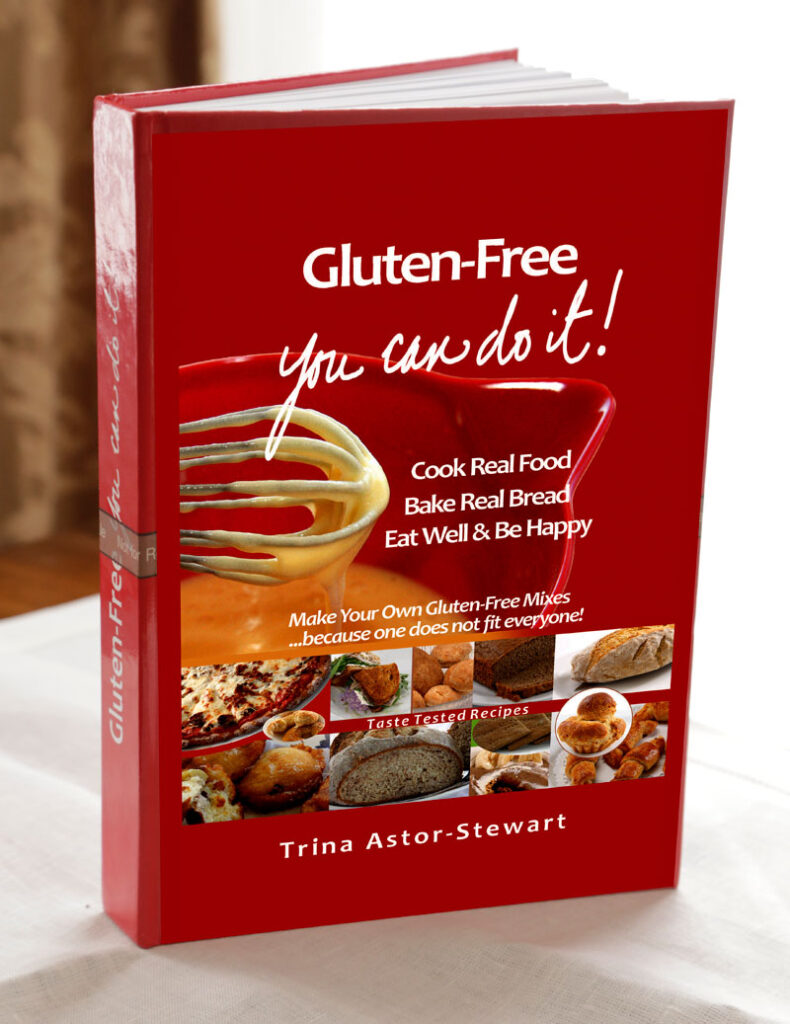
Gluten-Free, You Can Do It -by Trina Astor-Stewart.
Contains charts for Trina’s Gluten-Free Flour and Bread Mixes.
Three Series Of Seven Mixes Each: Original Mixes plus Corn, Nightshade, Tapioca, and Rice Free Mixes.
Over 300 Recipes. Each mix makes multiple recipes.
Available on Amazon in hardcover and ebook versions.
